The Ins and Outs of Every Competitive Stage in Melee
Learn about the six competitively legal stages in Super Smash Bros. Melee.
Learn about the six competitively legal stages in Super Smash Bros. Melee.
There are 29 stages in Super Smash Bros. Melee, but in competitive play, most are deemed unusable. Throughout the years there have been changes to the stage pool, and the community has settled on six viable stages. These are Battlefield, Dream Land, Final Destination, Fountain of Dreams, Pokémon Stadium, and Yoshi’s Story.
Within these, there are five starter stages and one pick specifically for counter-picking, which is Pokémon Stadium. Each one of these stages bear advantages for characters depending on the match-up. For example, Fox typically wants to avoid Final Destination when playing against Marth, but the same stage is considered to be beneficial to Fox against Jigglypuff.
In tournament play, the players decide on who bans first, usually through Rock Paper Scissors. The first player to ban strikes one stage, followed by the other player striking two. Then the first player decides on which stage they start on of the remaining two. In best of three sets, the winning player can ban one stage going into the next game. In best of five sets there are no counter-pick bans. In both kinds of sets, you cannot go back to a stage you won on unless your opponent agrees.
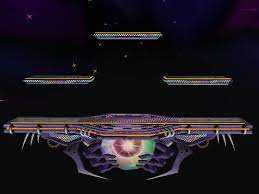
Source: SBWIKI
Battlefield is regarded as the most neutral stage among the stage pool. Most sets see this as the stage chosen for the first game as it has no real benefit to either player.
There are two side platforms and one top platform on Battlefield. The side platforms are high enough that most grounded attacks do not reach them from below. The heights and lengths of the platforms allow for tech-chasing from the ground through the platforms for most characters as well, as they are spaced enough that some combos will send the opponent to a side platform then to the top platform.
The blast-zones on this stage, which are the areas where you lose your stock if you touch them off-stage, are the most neutral in the game. The ledges on the stage are quite small, as they have lips underneath them that can trip up certain recoveries and lead to unwanted stock losses.
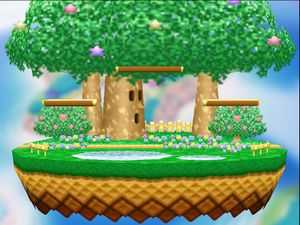
Source: SBWIKI
Dream Land is the largest legal stage with the largest blast-zones. Similar to Battlefield, Dream Land has two side platforms and one top platform. These platforms are more spaced out and higher than battlefield and other stages, making combos that travel throughout the platforms harder and sometimes unviable for different characters. Marth is a character that is hindered by this stage, as he cannot poke characters from below the side platforms with his up-tilt, which is a powerful tool of his.
The blast-zones being as large as they are lead to characters like Peach and Jigglypuff gaining an advantage. Because it takes much longer to take a stock off the top on Dream Land, these characters live much longer. Peach has a float and parasol that she can use during recovery that are hard to punish when she is high up, which is greatly aided by the large space above the stage. Puff has five jumps and her side-special, Pound, which make her horizontal recovery extremely difficult and risky to punish. With her losing her stock off the top much later, this makes this Puff’s best stage.
There are two quirks to this stage that can change the change the trajectory of the game. The first is the bottom of the stage that can cut off low recoveries. If you are caught under the bottom of the stage, chances are you are losing your stock unless you play it perfectly. Losing your stock by hitting the bottom of the stage is called getting “pineappled” in the competitive scene, as Dreamland’s lower section resembles a pineapple.
The other quirk to the stage is the tree in the middle of the stage, Whispy. This Kirby character will blow wind at random intervals towards one side of the stage, in the direction of the player with the highest controller port. This pushes grounded players and characters on the side platforms while it is blowing. This can mess up spacings for punishes and generally mess up players when they are trying to move and punish with precision.
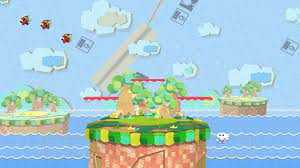
Source: Liquipedia
Yoshi’s Story has the smallest blast-zones among the legal stages as well as the lowest side and top platforms. Sheik and Marth benefit from these low platforms as their up-tilts can reach through the bottom of the side platforms, allowing them to apply safe pressure from below their opponents. Platform combos on this stage are potent, which also benefits characters like Fox and Falco.
The small blast-zones hurt characters that are light, like Peach and Puff, or rely on good horizontal recovery like Samus. This makes this a dangerous stage to be for these characters as characters with strong vertical launching moves like Fox’s up-smash are at an advantage once they tack on a little bit of percent.
There is a gimmick on this stage, which is a cloud that cycles through the stage and can help or hurt players off-stage if it is in the right place. The cloud, known in the community as Randall, comes out when the second digit of the seconds in the in-game timer is 4 and goes back into the stage when it reaches 9. When the first seconds digit is even it is on the left side and when it is odd it is on the right. Knowing the timing and how to use Randall to your benefit can win you a game, so be aware of where it is.
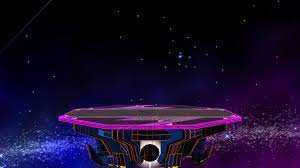
Source: Liquipedia
Final Destination is one of the more polarizing legal stages in the game. Depending on what character you play, and sometimes what character you are playing against, you either love it or hate it. Characters like Fox and Marth favor this stage most of the time, while Sheik and Jigglypuff tend to struggle on FD.
There are no platforms on this stage, making a lot of combo trees very different than most of the other stages. Some characters, like Fox, Marth, Peach and Pikachu can chain-grab Fox and Falco on this stage, with Pikachu and Peach also having a chain-grab on Captain Falcon here as well. Marth and Fox also benefit from the lack of platforms with their up-air strings they can get on most characters. The punish game on this stage can be brutal if you are not one of these characters.
The blast zones on this stage are average, though a bit on the smaller side. This can lead to some early off the top stocks. Landing and recovery are typically harder on this stage due to the lack of options to get down and back on stage. Punishes tend to follow flowcharts a lot more on this stage compared to the other stages, meaning that you should try to end your opponent’s stock as efficiently as possible.
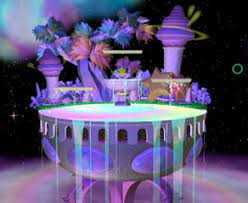
Source: SuperSmashBros Fandom Liquipedia
Fountain of Dreams is infamous for its side platforms, which move vertically randomly throughout the game, with no tell of when they will move or how much they will move. Sometimes both side platforms are at their standard height. Other times they have completely submerged into the stage. When playing on this stage, you have to constantly adjust your movement and gameplan depending on what the platforms are doing.
The vertical blast zones on this stage are the third largest, while the horizontal blast zones are the second smallest. This makes it a good stage for characters like Puff and Peach.
The platforms’ movements vary in their effects on characters. Captain Falcon and Falco are both hindered by them, with Falcon’s aerials and Falco’s lasers being stunted when the platforms get low. Sheik and Peach on the other hand, are benefited when they lower, as they have more routes to hit their opponents. When Sheik is below a lowered platform, she can apply nice pressure with her up-tilt and forward-tilt. When Peach is above her opponent on a lowered platform, her strong down-smash is extremely hard to avoid without taking some damage.
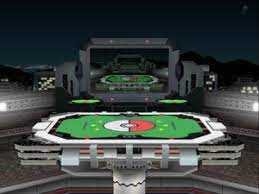
Source: SSB Wiki
Pokémon Stadium is unique for a few reasons. It is the only legal stage with two side platforms and no top platform. It also is the only legal stage with transformations.
Not having a top platform makes it hard for some characters to play defensive and avoid other characters neutral, like Falco using a lot of lasers. It also aids characters in their combo game as they can juggle their opponents without having to worry about them landing on the top platform. Captain Falcon loves this stage, as he has room to play neutral while not getting camped or having to chase characters to the top platform and getting punished.
The transformations are game changers. There are four different transformations that are cycled through at random in intervals throughout the match. The Grass transformation has two platforms at different elevations as well as a small part of a tree you can stand on. The Fire transformation has a big tree with a platform attached in the center of the stage, as well as a platform on the right of the stage. The Water transformation has a windmill that spins with platforms you can stand on for a small amount of time, as well as different elevations on the ground. There are also two platforms on the right of the stage at varying elevations. Finally, there is the Rock transformation, which has a giant rock that takes up most of the left side of the stage, leaving only a small sliver for the ledge. There are platforms on the right side of the rock as well as parallel to the rock, with a pit left in between them where characters like Pikachu and Fox can do infinite combos on the cast.
These transformations historically change the momentum of sets as they lead to random and unlikely plays that sway games in players’ favor. Having the ability to adapt and be consistent is the best way to combat the uncertainty that this stage often brings.
Having general knowledge on how your character is on every stage is very important to your success on improvement in Melee. Learning what works on some stages and not on others, what stages to bring different characters to, and what stages to ban are all key elements to competing and succeeding. Do not limit your practice to just one stage. Get comfortable with them all so you are not flustered if you have to go to a stage you are not as familiar with.